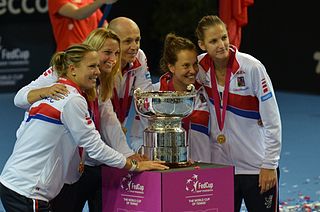The 1972 Federation Cup was the tenth edition of the most important competition between national teams in women's tennis. 31 nations participated in the tournament, which was held at Ellis Park in Johannesburg, South Africa from 20–25 March. South Africa defeated Great Britain in the final, in what was the first final not featuring United States or Australia, giving South Africa their first title. South Africa became the first team other than United States or Australia to win the Fed Cup.
The 1974 Federation Cup was the 12th edition of the most important competition between national teams in women's tennis. 29 nations participated in the tournament, which was held at the Naples Tennis Club in Naples, Italy, from 13–19 May. Australia defended their title, defeating United States in the final, in what was the fifth final featuring both United States and Australia.
The 1977 Federation Cup was the 15th edition of the most important competition between national teams in women's tennis. The tournament was held at Devonshire Park Lawn Tennis Club in Eastbourne, United Kingdom, from 13–18 June. The United States defended their title, defeating Australia in their seventh final.
The World Group was the highest level of Fed Cup competition in 2006. Eight nations competed in a three-round knockout competition. Russia was the defending champion, but they were upset in the first round by Belgium. The Belgians made the final, but they were defeated in the final by Italy.
The World Group was the highest level of Fed Cup competition in 2004. Sixteen nations competed in a four-round knockout competition. World No. 1 team France was the defending champion, but they were defeated in the final by World No. 5 team and four-time finalist Russia. As such, Russia ascended to World No. 2.
The World Group was the highest level of Fed Cup competition in 1997. Eight nations competed in a three-round knockout competition. United States was the defending champion, but they were defeated in the first round by the Netherlands. France ended up capturing their first title, defeating the Netherlands in the final.
The World Group was the highest level of Federation Cup competition in 1991. Thirty-two nations competed in a five-round knockout competition from 22–28 July. United States was the two-time defending champion, but Spain defeated them in the final to claim their first title.
The World Group was the highest level of Federation Cup women's team tennis competition in 1992. Thirty-two nations competed in a five-round knockout competition from 13–19 July. Spain was the defending champion, but Germany defeated them in the final to claim their second title and first since the reunification.
The World Group was the highest level of Federation Cup competition in 1993. Thirty-two nations competed in a five-round knockout competition from 19–25 July. Germany was the defending champion, but they were shocked in the first round by Australia, in what was the first time in the event's history where the defending team was defeated without winning a match. The defeat was especially significant as it involved a loss for then singles World No. 1 Steffi Graf at the hands of Nicole Provis. Prior to this match, Graf had defeated Provis in straight at their four meetings, and had never lost a Fed Cup tie.
The Knockout Stage of the 1994 Federation Cup Europe/Africa Zone was the final stage of the Zonal Competition involving teams from Europe and Africa. Those that qualified for this stage placed first and second in their respective pools.
The World Group was the highest level of Federation Cup competition in 1994. Thirty-two nations competed in a five-round knockout competition from 18–24 July. Spain was the defending champion, and they successfully defended their title defeating United States in the final.
The World Group Play-offs were four ties which involved the losing nations of the World Group first round and the winning nations of the World Group II. Nations that won their play-off ties entered the 2013 World Group, while losing nations joined the 2013 World Group II.
The Europe/Africa Zone was one of three zones of regional competition in the 1995 Fed Cup.
The World Group was the highest level of Fed Cup competition in 1998. Eight nations competed in a three-round knockout competition. France was the defending champion, but they were defeated in the semifinals by Switzerland. Spain defeated Switzerland to capture their fifth title.
The World Group II was the second highest level of Fed Cup competition in 1999. Winning nations advanced to the 2000 World Group, and the losing nations were demoted to the World Group II Play-offs.
The World Group II was the second highest level of Fed Cup competition in 2013. Four of the winners advanced to the World Group Play-offs, and the losing nations resorted to the World Group II Play-offs.
The World Group was the highest level of Fed Cup competition in 2002. Sixteen nations competed in a four-round knockout competition. Belgium was the defending champion, but they were defeated in the quarterfinals by Italy. Slovakia defeated Italy, and then Spain in the final to claim their 1st title and No. 1 ranking.
The World Group was the highest level of Fed Cup competition in 2003. Sixteen nations competed in a four-round knockout competition. Slovakia was the defending champion, but they were defeated in the quarterfinals by Belgium. France defeated United States in the final to win their second title and claim the World No. 1 ranking.
The World Group was the highest level of Fed Cup competition in 2014. The Czech Republic beat Germany in the final to win a third Fed Cup title in four years.

The 2016 Fed Cup was the 54th edition of the most important tournament between national teams in women's tennis. The final took place on 12–13 November and was won by the Czech Republic for the third year in a row, and for the fifth time in six years.
